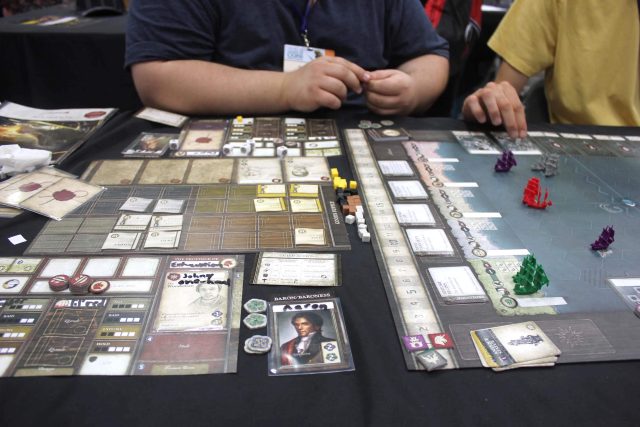Gen Con bills itself as "the best four days in gaming"—and in many ways, it is. More than 60,000 people crammed into the Indiana Convention Center in downtown Indianapolis to play, purchase, and demo the hottest new board games and RPGs releasing in 2016. The Ars crew spent several days at the show drowning in a delicious gaming gumbo; now that we're back, we've put together a list of the top titles we played at the show.
If you're looking for a solid overview of what's hot in board gaming for the second half of 2016, you've come to the right place. (And stay tuned for our coverage of the Essen Spiel fair in October for all your Eurogame needs.)Unless otherwise noted, these games should be hitting store shelves soon.
As a bit of "bonus action," we now have a new URL for all things board game-related: cardboard.arstechnica.com. Enjoy!
SeaFall
Plaid Hat Games, 3-5 players, 90-120 min, age 14+
Every Gen Con has its super-hyped, must-have game. This year, that game was Rob Daviau's SeaFall. As rumor has it, publisher Plaid Hat sold out of its limited copies even before the general public gained entry to the expo hall (damn you, VIGs!). Daviau previously designed Risk Legacy and the insanely popular Pandemic Legacy; SeaFall is his first game built from the ground up as a legacy title.
For the uninitiated, legacy games are generally played by the same group of players over a number of sessions (15 or so, in this case) because the game world permanently evolves due to players' actions and decisions. You'll write on the board, tear up cards, and generally make the game your own, unique experience. SeaFall is a 4X-inspired adventure game set in an "age of sail" swashbuckling world; Daviau has called it "Indiana Jones in the seventeeth century."
It's impossible to tell how the full thing will play based on an introductory demo, but it seems to have a decent amount of Euro-y resource management wrapped up in a choose-your-own-adventure-style storytelling engine. It remains a bit of a mystery, but I'm unreasonably excited to jump in and see what all the fuss is about. You can preorder the game here.
—Aaron Zimmerman
The Last Friday
Ares Games, 2-6 players, 30-120 min, age 14+

In hidden movement games, the hidden player is generally trying to escape from the visible players (think Mr. Jack, Letters from Whitechapel, and Spectre Ops) rather than trying to, say, chase them down and murder them with an axe as they hide in their cabins. But that's what sets The Last Friday apart. Here, you get to play one of the baddest of bad guys—an 80's horror-movie maniac—and hunt teenagers in a lakeside campground. FINALLY!
It sounds dark, but the game actually looks colorful and interesting, with changing goals across its multiple rounds. In round one, for instance, the campers need to find the keys to their cabins and hide there before the maniac catches them; in round two, though, the sun is up and the campers are after the maniac. The game sold out almost immediately, and demo plays didn't offer full games, but what we saw of the opening was certainly intriguing.
—Nate Anderson
Scythe
Stonemaier Games, 1-5 players, 90-115 min, age 14+
But that doesn’t mean that excitement for the alt-history 1920s mech-fueled strategy game had died down. Scythe was present on tables all across downtown Indy, and for good reason—it’s fantastic. Though it looks like a big ol’ dudes-on-a-map wargame, it’s much more of an intricate, puzzly Euro. You can read our review here.
—Aaron Zimmerman
Pandemic: Reign of Cthulhu
Z-Man Games, 2-4 players, 40 min, age 14+

Look, you're sick of Cthulhu. I'm sick of Cthulhu. At this point, even Cthulhu is sick of Cthulhu and is ready to just write Earth off in order to go raise the tides of madness somewhere else. But the Cthulhu version of Matt Leacock's blockbuster hit Pandemic is still worth a look.
Not just a re-skin, this one adds some real theme to the game with a beautiful new (and tight) map featuring Arkham, Innsmouth, Dunwich, and Kingsport, a set of tiny cultist figures, and three much larger Shoggoths. (I always found the "disease cubes" in basic Pandemic less than thrilling, so these are positive changes.)
In addition, a set of Old Ones cards across the top of the board gradually reveal themselves as gameplay progresses, making life more difficult for our heroes, who are cooperatively trying to close the four mystical gates on the map. All characters in the game have both a "sane" and an "insane" side with different abilities, should the tides of madness ever ride a bit too high, and the game comes with a nifty new "sanity die." This one looks like a worthy new edition of a classic. Even if it is about Cthulhu!
—Nate Anderson
Bloodborne: The Card Game
Cool Mini or Not, 3-5 players, 30-45 min, age 10+

Instead of focusing on the single-player action the video game is known for, the card game plops three to five players into a shared Chalice Dungeon where they will fight their way through a series of monsters and bosses. Even though you’ll work together cooperatively to take down the baddies, this is a competitive game. The goal of the game is to collect “blood echo” tokens from monsters by doing damage to them, but each monster only has so much blood to give.
Everyone plays one card simultaneously, and these cards will help you damage monsters or even mess with your fellow Hunters. You lose echos when you die unless you take an action to bank them and, true to its source material, you’ll die often in this game. Bloodborne is super interactive—it’s all about bluffing, negotiation, and trying to get into your opponents’ heads. Look for our full review soon.
—Aaron Zimmerman
reader comments
45